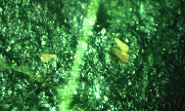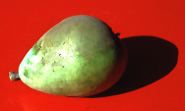
I. Introduction: The pear rust mite (PRM)
is found throughout the mid-Atlantic area where it
occasionally causes injury to foliage and russetting of the fruit. The
importance of this pest has
increased in some orchards where pyrethroid insecticides used in pear
psylla control have reduced
early-season populations of mite predators.
II. Hosts: PRM is found only on pear. Attempts to determine
whether it can become established
and reproduce on apple and related wild plants, such as hawthorn, have
failed.
III. Description: PRM is almost invisible with the naked eye and
appears identical in body form to
the ARM when viewed with a 20X hand lens. PRM is wider at the anterior
end, however, giving this species
a more "broad-shouldered" appearance (Plate 85). Adults are dull white
to pale brown and have wedge-shaped
bodies that are larger at the head than the tail end. The two nymphal
stages look similar in shape but
smaller. The round eggs are flattened, colorless when first laid, and
extremely small.
IV. Biology: The PRM overwinters solely as adult females beneath
bud scales of leaf spurs and under
loose bark of 1- to 2-year-old twigs. As the weather begins to warm in
early April, usually before buds
break, mites move to developing clusters and begin feeding on the
succulent parts of buds. Eggs are produced
shortly after mites become active. As buds open, adults and immatures
move to the expanding leaf tissue
and eventually to fruit as the leaves mature and harden. Immature mites
develop quickly through two instars,
each followed by a resting stage.
There are 4 or 5 generations each growing season in the mid-Atlantic
area, and each cycle takes only 10
to 14 days under warm summer conditions. During June and July, adult
males and females, eggs, and immatures
are commonly found together on the lower leaf surface and around the
calyx end of fruit. By late
summer, only females are produced and they soon move to protective
overwintering sites.
V. Injury: PRM feed on the surface of the leaves and fruit,
causing bronzing and russetting of
the epidermal tissue. Bronzing occurs first on the undersides of the
younger leaves near the midrib and
then gradually extend outwards. Discoloration is less evident on the
upper surface, which often remains
green. Leaf injury may stunt the growth of young trees but seldom
causes any photosynthetic reduction in
older, non-stressed trees.

After petal fall, more PRM move from the foliage to the fruit where
they first feed on the calyx end
and cause localized russetting (Plate 86). If populations are allowed
to increase, especially later
in the season, feeding and russetting may spread over the whole surface
of the fruit. Pears are downgraded
or rejected for the fresh market if the extent of heavy russet exceeds
10% of the surface of the
fruit. However, russet fruit is usually marketable for processing since
the damage is restricted to
the surface and thus removed with the peel.
VI. Monitoring: Because of their small size, sampling of PRM
requires careful examination of buds,
leaves, or fruit. Terminal and fruit buds can be opened during the
dormant season and again just before
bloom to determine the relative population level and distribution of
mites in an orchard. Since these mites
do not disperse readily, initial infestations are often confined to a
few trees.
After Bloom, leaf samples can be collected for brushing to detect the
presence of adult and immature
mites. If mites are active, a sample of 100 developing fruit should be
examined around the calyx end
for the presence of mites. For fresh market pears, treatment is
suggested if PRM infestations exceed
10 adults or nymphs per fruit. For processing fruit or naturally
russeted cultivars, the action threshold
is much higher.